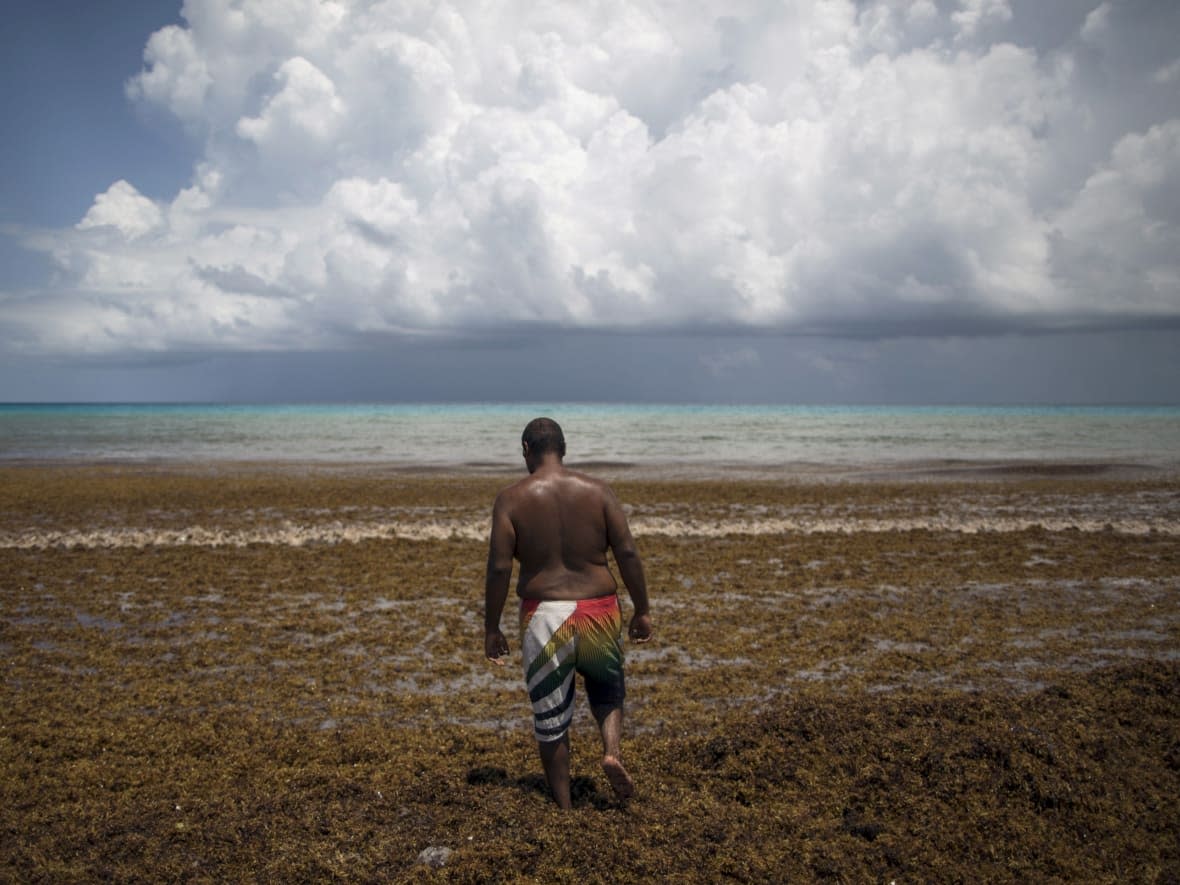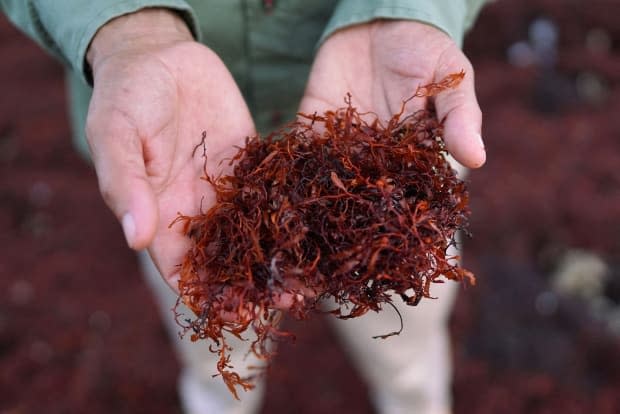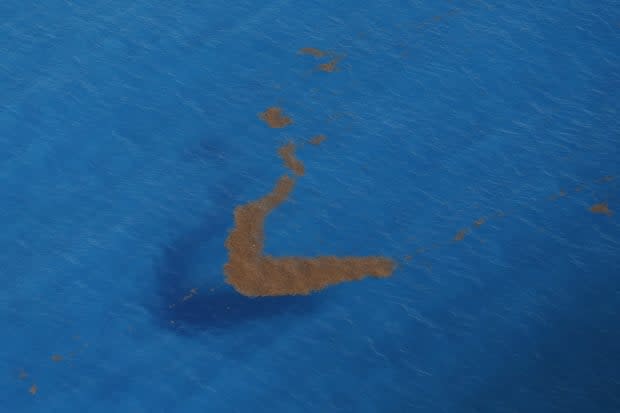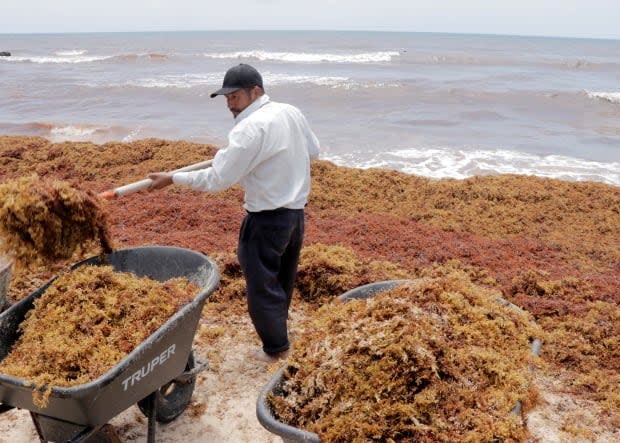Huge masses of foul-smelling seaweed in the Caribbean could cause headaches for sun-seekers

Every winter, millions of Canadians head down to the Caribbean in search of sunshine, pristine beaches and crystal-clear waters.
This year, however, tourists may have noticed something not-so-pleasant awaiting them on the beach: stinky, brown sargassum.
Over the past decade, the foul-smelling seaweed has become more common on beaches around the Caribbean and the south Atlantic Ocean. So what's going on? To understand, first you need to understand sargassum.
What is sargassum?
Sargassum is a type of brown seaweed (and a form of algae) found in the Atlantic Ocean. It is made up of leafy pieces, as well as oxygen-filled, round berry-like bits that help it float on the surface. It doesn't have any roots or seeds.
Unlike some other types of seaweed, it lives its entire life on the surface of the ocean in small patches. Sargassum is usually found in a region called the Sargasso Sea, where it tends to circulate in a vortex called a gyre, through a five-million square kilometre belt that runs from Chesapeake Bay in the mid-Atlantic, all the way to the Caribbean.
However, sargassum can clump together, creating rafts or or patches. It has a seasonal cycle, beginning in the spring, reaching its peak in the summer, and finally dying off in the fall.

Sometimes large collections can wash up on beaches, which can be an annoyance to beach-goers. But they're vital to some marine life, providing food and breeding grounds for animals such as fish, sea turtles and more.
"[Sargassum] has formed these enormous floating masses in the open sea, which are wonderful, actually … because they soak up carbon, they suck up nutrients, they sustain a lot of life, and a lot of animals depend on them," said Brigitta Ine van Tussenbroek, a scientist at the National Autonomous University of Mexico's Institute of Marine Sciences and Limnology.
"Even the American eel, the Northern European eel, they wouldn't exist without the Sargasso Sea, for example. So it's a wonderful system."
Is it increasing?
While most sargassum usually remains in this gyre, it can travel along a sort of conveyor belt in the Atlantic and Caribbean. Scientists have seen a noticeable increase in sargassum washing up on beaches in the Caribbean since 2011.
"Sometimes, some of these gyres … slackened, and some of the sargassum escaped and then went to Cuba, to Hispaniola, and some ended up in Mexico pass to the Gulf of Mexico. And then it went back to the Sargasso Sea," van Tussenbroek said.
"Since 2010–11, suddenly, some sargassum started to accumulate in a new area, which is just north of the equator in the tropical Atlantic."

Why is this happening? Scientists aren't sure.
A number of factors could be at play, including climate change and human activity, said van Tussenbroek.
Chuanmin Hu, a professor at University of South Florida who studies these blooms with their Sargassum Watch System (SaWS), said that a lot of nutrients come from the Saharan Desert dust that blows across the Atlantic Ocean.
But there's also ocean upwelling, he said, where water from deep below the ocean is brought to the surface, and along with it, more nutrients, which further supports these blooms. And, scientists believe that with a changing climate, there could be more ocean upwelling. As well, nutrients flow into the Atlantic from the Congo River in Africa and the Amazon River in South America.
"Now the question is, which is dominant?" Hu said. "We just don't know. It's difficult to quantify their contributions."
What is the situation this year?
According to SaWS, January was the second month in a row where sargassum doubled, which last happened in 2018. Though it dropped in February, the belief is that it will continue to grow and make its way along the shores of Caribbean nations. Last year saw the most sargassum ever recorded.
But so far, this year is impressive, Hu said, adding that that in December SaWS predicted that 2023 could be yet another record year, though there's no guarantee.
"All we can say is this would be another major year."
Just how much is there?
In January, there were more than eight million metric tons of sargassum in the Atlantic Ocean, Hu said. In February, that dropped to between six-to-seven million metric tons. But Hu said there could be even more in March.
"Right now they're scattered here and here with a low density. Even within the belt, the density is of less than 0.1 per cent," Hu said. "But if somebody could put all the sargassum in one place, what is the size of this? It's about, I think, 3,000 square kilometres, with no gap."

What are some effects of large blooms?
These large blooms that scientists have seen develop since 2011 are problematic. First, hotels and towns need to swallow the cost of removing these masses, in order to protect a lucrative tourism industry.
Then, there's the concern over ecosystems.

An abundance of sargassum can threaten delicate shoreline ecosystems, as well as smother coral reefs, reducing their cover and roughness, which makes them more susceptible to waves and have less protection from hurricanes. It can also prevent hatchling sea turtles from reaching the ocean.
The good news is that there could be some uses for the masses of sargassum, including using it as biofuel or even as building materials.
Should I be concerned?
If you're heading to the beach and encounter these masses, there is no immediate concern, though the smell as it breaks down can be unpleasant. And it could ruin that off-shore snorkelling or swimming you might want to enjoy.
"What I want to say now, you know to tourists is don't panic," Hu said. "This is a natural plant; it's not toxic. If you have too much, if [it decomposes], it may be harmful, but it's not toxic most of the time," Hu said. "
"And also most time, even if they accumulate on beaches, the local people typically remove them. So, if you have travel plans, come to Florida, come to the Caribbean. I wouldn't worry about things."
WATCH | Kelp and climate change:


